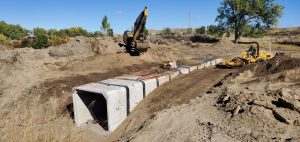Flume Replacement Project is a Win for Custer County, the Tongue and Yellowstone River Irrigation District and Montana Farmers!
Custer County secures an American Rescue Plan Act Water and Sewer Irrigation grant to help the Tongue and Yellowstone River Irrigation District keep water flowing to Montana farmers.

When a Montana Conservation Corps crew that had been removing thick stands of willow, cottonwood and Russian olive along Kircher Flume reported that its supporting timbers were rotten and the tin lining was leaking copious amounts of water, the Tongue and Yellowstone River Irrigation District’s board of directors were worried. The flume is a critical piece of agricultural infrastructure that brings water to farmers and the repair would be expensive. “I think it is safe to say that when a flume is held together by ratchet straps and rotten timber, it is time for a major overhaul,” recounts Mike Blum, the President of TYID.
Kircher Flume is located near Miles City along the historic Tongue and Yellowstone River Irrigation District. The Flume was constructed sometime in the 1940s and carries water downstream to farmers who grow hay and small greens on more than 5000 acres of agriculture fields. Agriculture is a powerful economic engine in Custer County. TYID water is provided to working lands that account for $110,000 in local tax revenue and a total production value of almost $7 million.
The dilapidated flume’s catastrophic failure would have effectively eliminated all irrigation to all producers and residences served by T&YID below Miles City. Surging water and runoff dumped into Kircher Creek would send sediment into the Yellowstone River. Heavy sediment loads are a form of water pollution that create murky water conditions, harming aquatic plants and animals. The flume’s failure could have also washed out an adjacent county bridge and utility lines.
Fortunately, in 2020, the Yellowstone River Conservation District Council (YRCDC) completed the Tongue and Yellowstone River Irrigation District Strategic/Long Range Plan which flagged the flume replacement as a high priority and set the planning process in motion. “The Strategic Plan really came from ground zero,” says David Pratt, a soil conservation specialist with the Yellowstone River Conservation District Council (YRCDC) and co-chair of YRCDC’s Irrigation Working Group. “Prior to the Plan, repairs were just done on an emergency basis.” The Plan was the first step in allowing TYID to inventory, prioritize and make long term plans for repairing critical infrastructure.
Custer County and the Irrigation District collaborated to complete the Kircher Flume Replacement Project. “Custer County recognizes the economic benefits the Irrigation District brings to our rural community,” says county commissioner Jason Strouf. “If our farmers don’t have the water they need to sustain their crops and livelihoods, we are all going to suffer.”
The County stepped in and secured a $343,091 ARPA Water and Sewer Infrastructure grant that provided the financing for the project while both Custer County and the TYID provided the match funds. This comprehensive construction project included removing the dilapidated flume and wooden supports and the Kircher Creek Bridge; installing a concrete box culvert; constructing a lined channel for the TYID canal; installing riprap at the inlet and outlet of the new Kircher Creek Culvert; and replacing the wastegate headworks.
If the ARPA funding hadn’t come through, the Irrigation District would have had to take out a loan with payback being up to twenty years,” states David Pratt. “The strategic plan has also been instrumental giving us the tools and ability to prioritize repairs across our entire Tongue and Yellowstone River Irrigation District system.”
View original article on the Montana Department of Natural Resources & Conservation website >
